True/False
Indicate whether the
statement is true or false.
|
|
|
1.
|
On systems that must maintain positive speed, synchronous belts, rather than
V-belts drives should be used.
|
|
|
2.
|
A V-belt is considered a relatively efficient means of power
transmission.
|
|
|
3.
|
The transmission of power by yhe V-belt drive depends on effective tension or
net pull.
|
|
|
4.
|
A V-belt is a toothed drive that doesn’t slip.
|
|
|
5.
|
When using V-belts, higher speed means more net pull.
|
|
|
6.
|
Idelers should be avoided because they have a tendency to shorten belt life and
reduce power ratings.
|
|
|
7.
|
Belt drives use sprockets to pull the belt.
|
|
|
8.
|
Sheave alignment is not critical for the drive to run trouble-free.
|
Multiple Choice
Identify the
choice that best completes the statement or answers the question.
|
|
|
9.
|
V-belts that are used for light duty service.
a. | Classical | c. | Fractional Horsepower | b. | Notched | d. | Banded |
|
|
|
10.
|
V-belts that can referred to as an industrial standard.
a. | Classical | c. | Fractional Horsepower | b. | Notched | d. | Banded |
|
|
|
11.
|
V-belts that can relieve bending stress.
a. | Classical | c. | Fractional Horsepower | b. | Notched | d. | Banded |
|
|
|
12.
|
V-belts that are joined together.
a. | Classical | c. | Fractional Horsepower | b. | Notched | d. | Banded |
|
|
|
13.
|
This is a ________________. 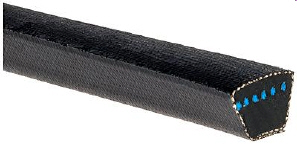 a. | V-Ribbed Belt | c. | Synchronous Belt | b. | V-Belt | d. | Flat Belt |
|
|
|
14.
|
This is a ________________.  a. | Notched V-Belt | c. | Synchronous Belt | b. | V-Belt | d. | Banded V-Belt |
|
|
|
15.
|
This is a ________________. 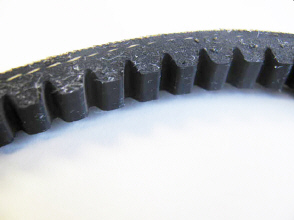 a. | Notched V-Belt | c. | Synchronous Belt | b. | V-Belt | d. | Banded V-Belt |
|
|
|
16.
|
This is a ________________. 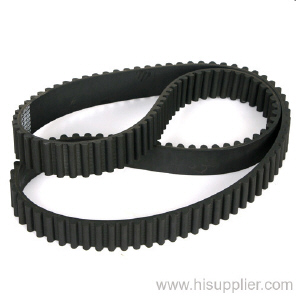 a. | Notched V-Belt | c. | Synchronous Belt | b. | V-Belt | d. | Banded V-Belt |
|
|
|
17.
|
This is a ___________. 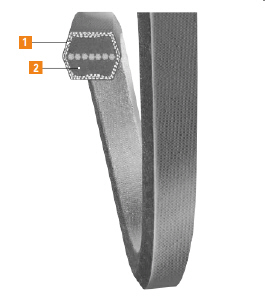 a. | Classical V-Belt | c. | Double Angle V-Belt | b. | Narrow Section V-Belt | d. | Notched V-Belt |
|
|
|
18.
|
This is a ________________. 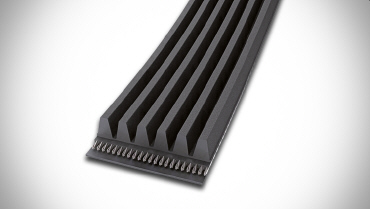 a. | V-Ribbed Belt | c. | Synchronous Belt | b. | V-Belt | d. | Flat Belt |
|
Completion
Complete each
statement.
|
|
|
19.
|
The modern V-Belt drive was developed in the early twentieth century as a means
to transmit ________ safely and efficiently.
|
|
|
20.
|
The advantages of V-belt drives include low relative _______, quiet operation,
no lubrication, energy efficiency, a broad range of available ratios and sizes, shock aborbancy, and
easy installation.
|
|
|
21.
|
A _______________ belt is a toothed drive belt that does not slip.
|
|
|
22.
|
V-belts make use of the ____________ principle of the wedge and the belt being
in tension between the driver and driven shafts.
|
|
|
23.
|
V-belts depend upon __________ contact between the sidewalls of the sheave and
belt to transmit power.
|
|
|
24.
|
What is the inside circumference of this belt? 
|
|
|
25.
|
What is the top width of this belt? 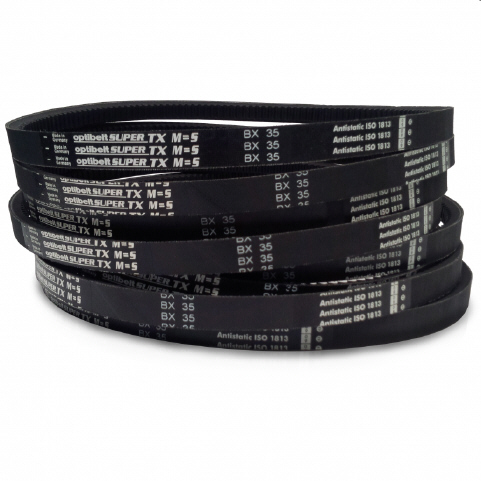
|
|
|
26.
|
The “X” series is a _____________ version of the belt. 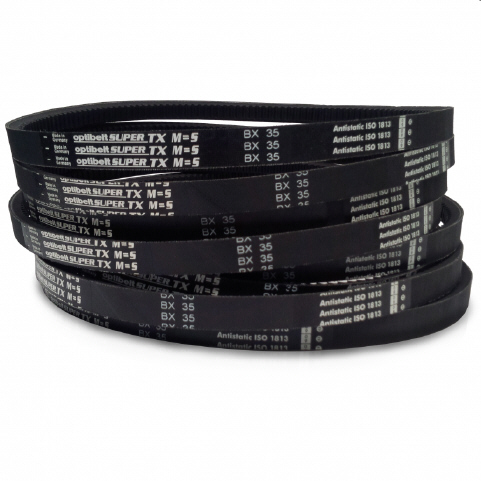
|
|
|
27.
|
V-belt _________ are grooved wheels that are designed to run with the correct
corresponding belt.
|
|
|
28.
|
The critical dimension used in identifying and sizing the sheave is the
_________.
|
|
|
29.
|
Certain sheave types called combination or “_____ ____ “ allow
more than one belt cross-section to be used.
|
|
|
30.
|
Variable speed belts have their own form of variable _______ sheaves.
|
|
|
31.
|
_____________ belt drives are referred to by a variety of names, one being a
“timing belt”.
|
|
|
32.
|
Synchronous drive belts have ______ that are accurately molded to conform with
and engage the teeth of the matinf pulleys.
|
|
|
33.
|
With a Synchronous belt, there is no ________ of the belt that would allow speed
variation and inefficiency.
|
|
|
34.
|
Calculate the belt length for a drive system that has a center distance of
36”, a large sheave with a diameter of 16” and a small sheave with a diameter of
6”. Round you answer down to the nearest whole number (don’t use a decimal)
|
|
|
35.
|
Calculate the span length for a drive system that has a center distance of
36”, a large sheave with a diameter of 16” and a small sheave with a diameter of
6”. Write your answer with one decimal place.
|
Matching
|
|
|
a. | Bearling Loads | d. | Center Distance | b. | Arc of Contact | e. | V-Belt Drive Ratio | c. | Idler |
|
|
|
36.
|
The amount of belt wrap around a sheave groove expressed in degrees.
|
|
|
37.
|
In a V-belt drive system, the distance between the centerline of the driver and
the driven shaft.
|
|
|
38.
|
The difference in diameter between the driver and driven sheeves.
|
|
|
39.
|
A combination of sheave or pulley weight and the belt pull.
|
|
|
40.
|
A belt tightening sheave or pulley on a drive to increase tension.
|
|
|
a. | Banded Belts | d. | Double Angle V-belts | b. | Narrow Section V-Belts | e. | V-Ribbed Belt | c. | Open End
Belts |
|
|
|
41.
|
A single endless rubber and fiber belt with a series of v-ribs molded
lengthwise aroun the inside circumference.
|
|
|
42.
|
Compact belts that can do more work in less space.
|
|
|
43.
|
Their shape permits them to transmit power from both the top and bottom half of
the belt.
|
|
|
44.
|
Belts designed for emergency replacement.
|
|
|
45.
|
V-belts that are joined together with a permanent tie band.
|